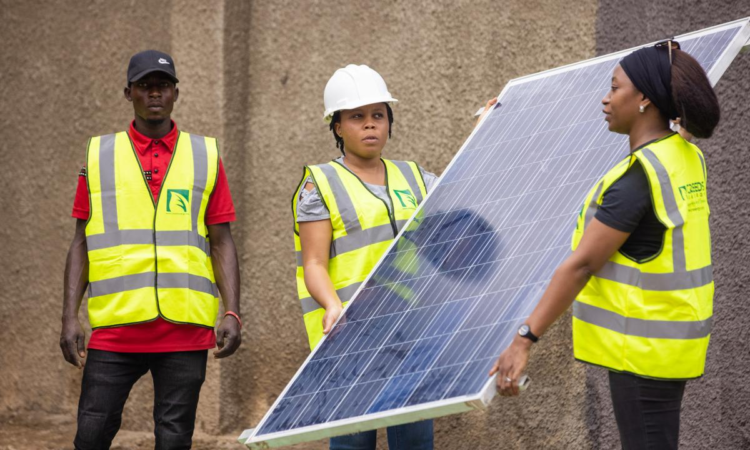
Stay in touch
In 2021, as part of its National Economic Sustainability Plan (ESP) for post-COVID-19 recovery, the Federal Government of Nigeria announced a plan to electrify 304 healthcare facilities and schools across the country. While this remains a priority, several significant barriers need to be overcome. For instance, data on health facility operationality, their electrification status, and energy needs is sparse, outdated, and stored in multiple locations. Moreover, existing datasets are inconsistent with limited to no information on ownership or management structure.
The Powering Healthcare Nigeria Market Assessment and Roadmap was developed by Sustainable Energy for All (SEforALL), under the Power Africa-funded Powering Healthcare Africa Project, to provide the Government of Nigeria and its development partners with a data-driven overview and practical recommendations for planning and coordination of electrifying the country’s underserved health facilities. The document consists of stakeholder and interventions mapping, data analysis, technology assessment, funding and financing mechanisms, and delivery models. It was developed in coordination with the Rural Electrification Agency (REA), the National Primary Health Care Development Agency (NPHCDA), USAID Nigeria Power Sector Program (NPSP), and USAID Integrated Health Program (IHP).
“Data is an invaluable asset in the Nigeria energy space as it guides the way for impactful deployment of infrastructure across critical sectors. The quality of data in the Powering Healthcare Nigeria Market Assessment and Roadmap is particularly commendable and timely as it enables the Federal Government and its key development partners sufficient information to strategically power healthcare centres across the nation with clean, safe and reliable energy needed for quality healthcare service delivery,” said Ahmad Salihijo Ahmad, Managing Director, Rural Electrification Agency of Nigeria.
Sector interviews reveal a significant increase in health facility electrification interventions from 9 interventions cumulatively targeting 339 health facilities in the past 6 years, to a more ambitious 19,659 health facilities being targeted by 11 ongoing and planned interventions. However, health facility electrification interventions are still heavily donor dependent with minimal private sector involvement. Healthcare service delivery is also severely impacted by a lack of infrastructure and resources.
By Federal Ministry of Health estimates, Nigeria currently has roughly 1.4 healthcare facilities per 10,000 people. Around 85.3 percent of these facilities are primary healthcare facilities (PHCs), of which 28,036 are publicly owned. From key informant interviews with 34 stakeholders operating in Nigeria, an estimated 30-40 percent of the public PHCs are considered functional, and around 40 percent of the functional PHCs are without access to electricity.
More detailed (but less nationally-representative) needs assessments indicate that PHCs have on average 6-10 hours of power supply, with less than 20 percent of PHCs using solar power. While PHCs vary widely in size and services offered, on average solar PV systems with a capacity between 5-10 kWp are sufficient to meet energy demand.
The majority of PHCs are publicly owned and therefore have limited budgets for electricity supply investments or payments for operational activities. These expenditures or other deficits are often supplemented by household out-of-pocket expenditure and user fees.
The National Primary Healthcare Development Agency (NPHCDA) has outlined a revitalization plan targeting 10,000 PHCs (1 per ward), prioritizing Type 2 PHCs under its 1 PHC per ward plan. SEforALL’s analysis shows that to electrify 10,000 PHCs and keep the systems operational for 15 years, USD 525 million is required (USD 300 for CAPEX, and USD 225 million for OPEX). The health budget is on average 5 percent of the total national budget – far below the Abuja declaration of 15 percent – and is inadequately funded to meet this financing need.
The Roadmap identifies three relevant models: a traditional equipment ownership model, a service-based model, and a hybrid model. The document finds that a traditional equipment model in which a donor agency provides the initial capital for system installation (mainly through grants) is most appropriate for health posts with smaller-sized SHS systems with minimal O&M requirements.
A service-based model, in which a public agency selects a service provider to provide electricity services (design, procure, install, operate, and maintain), typically over a 10–15-year period, would primarily suit general hospitals with good management capacity and a strong ability to pay. A hybrid model, which combines elements of the previous two models with increased use of blended financing, is found to be most appropriate for type 2 PHCs.
“This Roadmap culminates months of intensive on-the-ground research and will provide a critical assessment of electricity needs and the market conditions necessary for electrifying health facilities in many rural areas of Nigeria,” said Mark Carrato, Coordinator, Power Africa. “We are eager to see the Roadmap implemented through the determined efforts of USAID’s partners in the Government of Nigeria, including REA and NPHCDA, the World Bank, and others.”
For progress in universal health facility electrification in Nigeria, the Roadmap recommends:
“In the proposed actions, the NPHCDA and REA have important roles to play in stewardship, data governance, planning, resource mobilization and coordination,” said Luc Severi, Programme Manager, Powering Healthcare at SEforALL. “There are also opportunities for better coordination by leveraging a multi-sectoral coalition such as the Coalition for Sustainable Electrification of PHCs. SEforALL is committed to advancing these recommendations and invite our partners and other key stakeholders to join us.”
Case study
29 Mar 2022
Case study
15 Mar 2022
News
31 Mar 2021
Opinion
21 May 2019
Keep up-to-speed with what's happening at SEforALL and across the sustainable energy movement. We'll send you our monthly update, plus special news and event invites.







